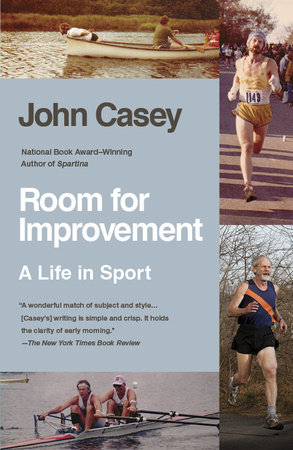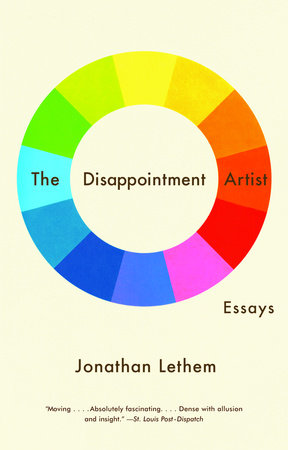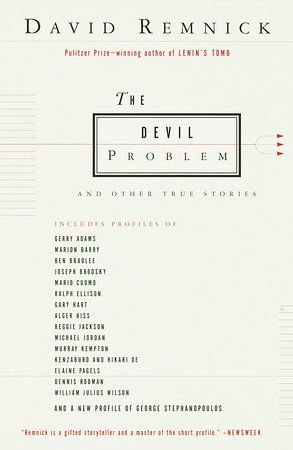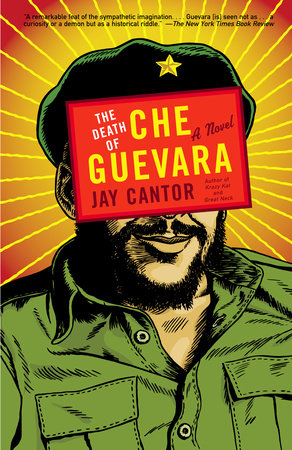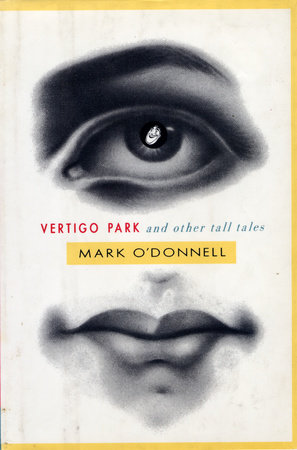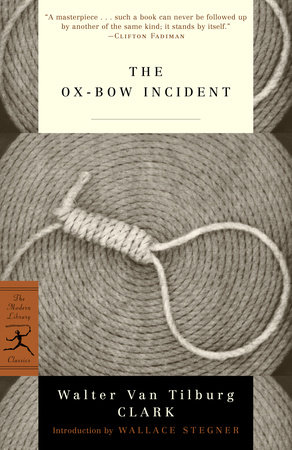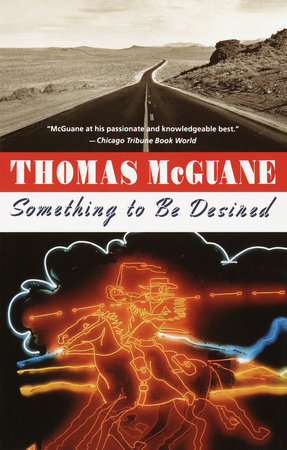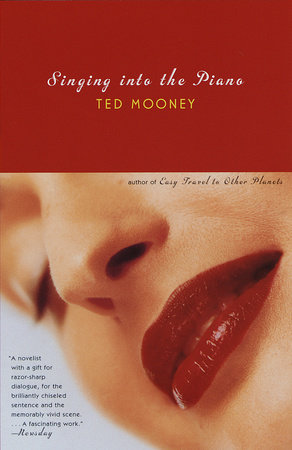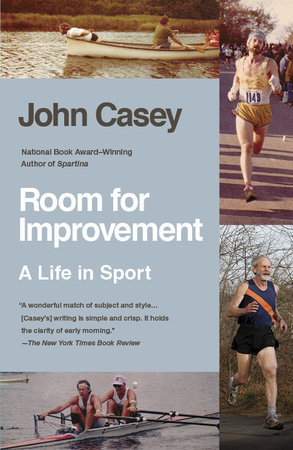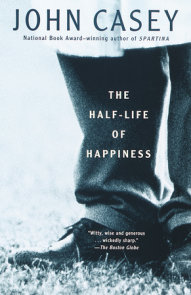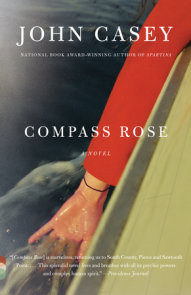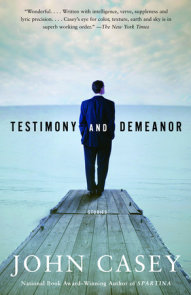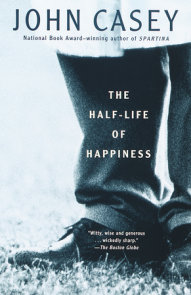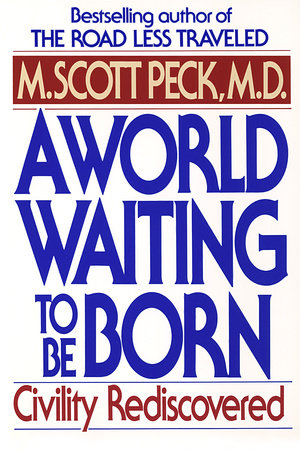Author Q&A
A Conversation with
John Casey
author of
ROOM FOR IMPROVEMENT
Notes on a Dozen Lifelong Sports
Q: Many people can exercise for one day or one week, or train for one race. But you write about participating in sports throughout your life—you even biked, rowed, and rollerbladed for 70 kilometers on your 70th birthday! What are some tools to help people stay fit for their whole lives, rather than for an isolated stint?
A: There are lots of good reasons to exercise (health, vanity, sense of well-being, etc.) and some less obvious reasons (what you get to see in the woods or on a river), but I’m going to take your word “tools” literally. I’ve often been urged into doing things by tools. My old axe, newer splitting maul, cross-cut handsaw, pick & shovel call out—they practically sing that old Puritan hymn, “Come labor on! Who dares stand idle on the harvest plain…”
Q: How did you become interested in sports and the outdoors? Were you encouraged to participate in sports as a child?
A: There was a lot of mens sana in corpore sano in schools and scouts, but even earlier in my large extended family. We Casey children often got parked with our Dudley relatives, mostly happily. But when I was very little (four or five) I was at my grandmother’s house in Hanover, New Hampshire. Lots of snow. She put me on a pair of old-fashioned skis and told me to shuffle my way to a nearby hill. If I got up it (and, presumably, down), I’d get supper. I fell in the front yard. I couldn’t get up. Ski poles and skis were in a tangle in the deep snow. I saw my grandmother pull back a curtain to peek. I thought, She’ll take pity on me. I waited. She out-waited me. Stern Yankee.
On the other hand my father couldn’t resist tap dancing wherever there was a hard floor, often singing “East Side, West Side” as he waltz-clogged. I’ve taken to doing that too.
There’s stern Yankee and there’s Irish exuberance. Both ways had an effect.
Q: You write about your Outward Bound solo (four days alone in the woods), “usually the nature of time is social. Measured by obligations to other people. Work. Lunch. Dinner. Who, when. Here the only events are sunrise, sunset, high tide, low tide.” In an age in which most people can’t go a day without a cell phone or a computer, what can we learn from this book about slowing down and appreciating what’s around us?
A: My solo on a tiny island off the Maine coast was bliss. I got a little fancy writing that part; the Proust/Joyce contrast is okay, but it came from looking back. To put it more simply, when you’re alone for a good spell, it’s pleasant to find that you’re good company for yourself, your mind humming along companionably, but it’s better to find that WHERE you are is even better company. I loved every bit of that island. At high tide it wasn’t much bigger than a basketball court, but it got bigger the clearer my senses became.
The solo in a snow cave was up and down. Well, up/down/up. Nothing to do with the Maine woods in winter; I just happened to start thinking about something very sad. That ran its course. The snow and the trees came back. How many colors there are in the bark of a white birch. The young ones have a touch of rose.
Nothing urgent. That’s pretty much it. Nothing urgent.
Q: About your Outward Bound course on Hurricane Island, you write, “I think it a wise decision to provide the equipment there. Otherwise there would be some people showing up in hundred-dollar seagoing outfits and others showing up with see-through plastic galoshes that would dissolve the first time they touched a barnacle-covered rock.” Outside of Outward Bound, can athletics transgress class boundaries? Given how expensive it can be to play ice hockey, and how inexpensive it can be to play soccer, how do sports divide or unify us?
A: Oh, don’t pick on ice hockey. Lots of kids in Canada and northern US start playing pick-up hockey on frozen ponds—no body-checking, no lifting. They move on to full-body hockey using Uncle Mike’s or cousin Pierre’s hand-me-down pads. Expensive? Polo. But back to Outward Bound: good call by OB to outfit everyone the same. And that’s not the only democratizing that goes on. In my two Outward-Bound courses it sooner or later became clear that we needed each other and that some people had a particular skills that came in handy or virtues that served us all well. Didn’t always work out for every boat or group, but closer to the Sermon on the Mount than to Donald Trump.
Q: Competition and sports are so connected, yet you say, “Medals? Medals are for wind chimes. What you love is the gracefulness of rowing or paddling or skiing, to connect with the grace inherent in boats or skis, and the grace with which they move on water or snow,” and “there are many reasons to keep doing sports into middle and even old age—health, vanity, endorphins, adventure—but another good reason is a partner.” Throughout the book, you focus on the companionship more than competition. Why is it so important to focus on a partner instead of just focusing on winning?
A: “Medals are for wind chimes.” That’s a smart-ass remark all by itself. It comes as half of a reflection on “indoor-rowing” competitions, the eco-puritan half of me that wishes that the rowing machines could at least be generating electricity. The whole truth is that there’ve been some medals that mean a lot. And I’m not downplaying competition. Being in a race has got me to do things I couldn’t have done otherwise.
I don’t think I focus on companionship OVER competition. As I got closer to the end of the book, companionship came into focus on its own. There are comments on coaches and comrades all along; I thought it was time to say how helpful it is to have friends who get you off your chair and out the door.
Q: You begin with a story called “I Got Fat in Law School.” Why did you choose to start with this one?
A: Maybe I thought it made sense to start with a national problem. Listen to Michelle Obama; see the movie “Supersize Me”. Fat was a problem for me. Not so much after the age of 26. Sports and exercise, especially long-distance events, burn fat.
The old conventional wisdom was that since running a mile burns only 100 calories, you’d have to run 36 miles to lose a pound. But what makes exercise work to reduce fat is that there’s an after burn following exercise that goes on for an hour or more. And—further bonus—jogging a few miles cuts the appetite.
I don’t know if this is physiological or psychological, but I don’t crave fat food when I’m in training. Yes, food is wonderful. There’s a blessing I’ve heard of—I think it’s from a Pacific island: “Thank you, Great Spirit, for making food taste good when you didn’t have to.” Yes. I’d add, “Thank you, Lord, for giving us the urge to play games, to run and dance.”
Q: The title of another story, “Room for Improvement” is a quote from a distance runner who was rather rude to you after you completed a 50-mile run! Why did you choose this title?
A: Yes, the distance runner WAS rude. So rude it embarrassed my student who was proud of and being nice to his old prof who’d at least completed the JFK 50 mile event in 10 hours and change. The distance runner was rude but right. And it was a swift incision. If he’d said,”Well, at least you finished”, it would have been worse—a considered combination of pity and condescension. On the whole I’d rather hear what’s on someone’s mind pop right out. If it has the rhythm of a punch line, someday it’ll be funny.
I’m glad I laughed at what the distance runner said. And I should thank him for giving me a title. Titles are hard. Though not as hard as comedy, so I should thank him for that too. Hey, distance runner, if you happen to read this, Thank you. “Room for Improvement” I hope conveys that there are as many prat falls as medals.
Q: There are many important survival tips in this book, including this one: “most [dangerous organisms] cam be killed by a ten-minute boil—up from the five-minute boil suggested in most survival manuals: the bacteria are getting hardier.” What are the most important things that people show know before embarking on a survival-style trip?
A: All of the “survival” courses I’ve done have been carefully directed. The only time I had a problem was when I went into a mile-long cave under a large mountain. On the way back the amateur guide stopped in front of two shafts. He said, “I THINK we should go left.” He pondered for far too long and then said, “No. Right. I’m pretty sure I remember…” It was fifty-fifty. Luckily right was right.
So the only tip I offer is be sure the people in charge are pros. An amateur once told me that it was safe to eat any fungus that grows on trees. I checked this with a professor of mycology. He said, “Oh my God no.”
Q: Tom “The Tracker” Brown is quite a character! In response to someone who says “that’s only a vulture,” Tom says, “Have you climbed up to look in a vulture’s nest and had one puke in your face? That’s what a vulture does. When you’ve had one puke in your face, then you can say ‘only a vulture.’” Who is the most interesting teacher or coach you’ve encountered?
A: Tom “Tracker” Brown was like March—came in like a lion left like a lamb. Blustery, even scary at first but good with people who made an effort.
The best instructors I’ve had are those who first of all make the mechanics clear and simple. Then, once the basics are in place find a way to convey what it FEELS like to do it right. Brett, my old sculling coach and pal, said, “When you come forward on the recovery, don’t just push your arms. Imagine you’re a great blue heron spreading his wings for the next wing beat.” Another coach at a sculling camp said, “On the recovery you’re a ballerina. On the drive you’re a tiger.” Instructors of logic and rhetoric say, quite rightly, that analogies can’t prove a point. Good instructors, whether of javelin throwing, dance, sculling or any exercise in which form matters as much as power, know that analogies can MAKE a point.
But you ask for memorable. Here’s a bit of memorable. My high-school football team played Georgetown Prep, a Catholic school. Before the kick-off the coach got our defensive line together. We liked Snaky Graham; we knew he liked us. He knew football, but a few other things were vague. Our defensive line was Flynn, Lynn, Casey (Irish Catholics) and Ed Smith (southern Maryland Catholic). The climax of Snaky’s pep talk was,”AwRIGHT! Now go in and get those boys with the beads. Get those mackeral snappers!”
We linemen looked at each other for a second and agreed, without a word, to let it float. We put our paws together and growled our pre-game growl. We never told this to anyone, especially not to the art teacher who often made fun of Snaky. I haven’t thought of this for years. I’m cheered to think that teenage boys every once in a while do the right thing.
Q: You write “all of [Tom Brown’s] course’s survival techniques—how to get out of the woods alive—while potentially useful and compellingly ingenious, aren’t as important as the suggestions about how to get into the woods.” What do you mean by this?
A: The first thing that occurs to most people when they hear “survival” is the scenario of getting lost, of getting stranded in a car in a blizzard or in the desert, a plane crash in the wilderness. All that is the scare, the stick so to speak, of why to learn how to make fire by the bow-drill method, how to make a debris shelter (good to 20 degrees below zero), how to suck water from a wild-grape vine or from an improvised solar still, how to trap small animals or kill them with a throwing stick. Fire, shelter, water, food—the basics of how to get out of the woods.
But the carrot of the carrot and stick is how much there is to see. How to get INTO the woods. The unfocused, peripheral-vision lesson, the tracking and stalking—not just seeing but listening, smelling, tasting—lead to an enlargement of the senses, an enjoyment of the senses. These were good lessons for me in general.
And, by the way, they were more specifically useful when it came time to write scenes in Spartina and Compass Rose in which Elsie, a natural resources officer, discovers, interprets and marvels at what’s going on in the woods and marshes of Rhode Island. I had my own log books and memories, but the Tom-Brown sessions put a sharper edge on my attentiveness, made me more of a “sojourner in nature”. Elsie gets up to a lot of things, but losing herself in nature is her indisputably good side. Her twenty years of sojourning are distilled from my own more scattered half-century of wanderings.
Q: During your winter Outward Bound course, you write about “the day the toilet paper got wet and we had to use snowballs. (Not as bad as you’d expect.)” This book is much funnier than people might expect out of a sports memoir. Was this an intentional choice on your part?
A: Oh yes, I remember snowballs instead of toilet paper. At the time they seemed a practical expedient, but in retrospect I saw an echo of Rabelais (see his discussion of alternatives to toilet paper or whatever folks in era were using). A snowball, I should add, is as good a wake-up as a cup of coffee.
Did I intend to be funny? I did indeed. Of the twenty-four chapters in Room for Improvement fifteen have something or several things that made early readers laugh. There are as many prat falls as medals, most of them my own but a few involving other people’s prats.
Q: What’s next for you?
A: I’ve stopped asking college seniors “What are you doing next year?” because all too frequently their faces show anguish or terror. I do have a book of stories that will be part of the Rhode-Island trilogy, but they’re done and under contract. I also have a collection of essays, but they’re also finished except for the business of finding a home.
As for ”what’s next” for me in terms of putting pen to paper: anguish or terror.
Oh, there is a GLIMMER of something. It could turn into a story…maybe a novel.
Or maybe a haiku.
For booking information:
Erica Hinsley / 212-572-2018 / ehinsley@randomhouse.com
